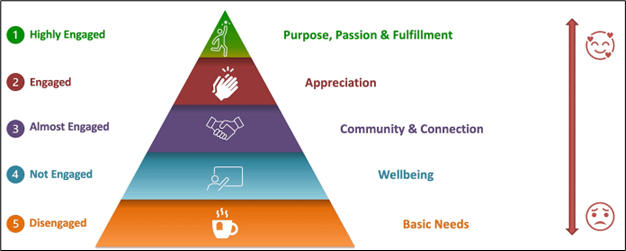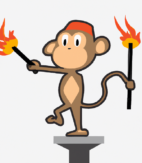Bob Morris is the Executive Director of Delivery at ThreeWill. Bob leads the delivery of all services which focus on helping clients leverage Microsoft Cloud technologies to provide innovative business solutions and drive real value through people-focused adoption programs.
The internet is full of recommendations for developing engaged/thriving employees. This blog provides a ThreeWill perspective on what strategy is vital to developing highly engaged employees and an essential tactic for practically promoting this strategy.
If you’ve read ThreeWill blogs or seen our website, you know our focus is helping employees thrive. Why? Thriving employees are engaged, productive, and fulfilled by their work. They are motivated to do their best every day and see their success intertwined with the organization. In short, thriving employees critically impact our client’s bottom line. The benefits to organizations with thriving employees are myriad: increased productivity, reduced costs (increased retention, decreased absenteeism, etc.), increased innovation, and improved customer service, to name a few. Look at Will Holland’s blog on the Total Cost of Disengaged Employees to Your Organization for a deep dive into this.
What strategy do we see as key?
We work with businesses covering a broad spectrum of sizes and industries. Conceptually, we consistently see that Maslow’s familiar hierarchy of needs (1) provides a helpful guide for developing engaged/thriving employees. The figure below shows a ThreeWill take on this hierarchy my colleague Mike Homol developed in his Digital Employee Engagement: What, Why, and How? blog.

This figure indicates that employees are motivated to fulfill their needs in a hierarchical order. This order begins with the most basic needs (bottom of the pyramid) before moving on to more advanced needs (top of the pyramid). It indicates that the most highly engaged employees are those whose needs for purpose & fulfillment have been met. In other words, the key to developing the most highly engaged (and thriving employees) is providing an environment that fosters purpose and fulfillment.
Our experience indicates that the key to providing this type of environment is creating a growth-oriented organizational culture. This concept, initially proposed by Dr. Carol Dweck (2), refers to an organization that believes in the ability of all employees to grow and develop their skills and capabilities. It provides opportunities for employees to perform work outside their previous experience, training, or skill levels. These organizations recognize that these opportunities might result in successes or failures. However, they also ensure that failures provide valuable learning experiences that can provide the basis for future successes.
Is tolerating failure practical?
One of ThreeWill’s core values is “choose growth”, which stems from our belief in the benefits of a growth-oriented culture. We’ve been helping clients achieve successful business outcomes for over twenty years, and an important part of our pedigree is based on Agile Principles, which includes the concept of “learn fast”. “Learn fast” encourages continuous improvement via early experimentation and learning from failures as quickly as possible to achieve successful outcomes.
This concept has been adopted by a subsidiary of technology giant Google called “X”. “X” is also known as the Google “the moonshot factory”. “X” invests in many big projects that could potentially have successes with enormous payoffs or failures with huge losses. For every success, there can be multiple failures. So, the best interests of “X” requires that projects that will ultimately fail be identified as quickly as possible. In her book entitled “Quit” (3), author Annie Duke discusses a mental model developed by the CEO of X, Eric “Astro” Teller to help “X” employees become “better quitters”, i.e., identify failing projects sooner.
This model is called “monkeys and pedestals” and is based on a hypothetical money-making endeavor where you are trying to train monkeys to juggle flaming torches while dancing on pedestals in a public performance. This endeavor requires two main tasks: 1) training a monkey to juggle flaming torches and 2) building pedestals. The “monkeys and pedestals” model encourages you to accomplish the more challenging task first with the logic that if you fail at training the monkeys, at least you won’t have wasted money on building pedestals. In fact, “X” employees have been known to include the hashtag “#MONKEYFIRST” in project presentations.

The “monkeys and pedestals” model tells us that it’s OK to try difficult projects or for employees to attempt tasks outside of their current capabilities. However, it should be done in a way that accelerates any potential failures as early as possible so that learning is a quick and continuous by-product of these failures.
The bottom line is that companies (large or small) with growth-oriented cultures have more thriving employees that are more productive, innovative, and less likely to look for other employment opportunities. These organizations promote a growth mindset where failure is tolerated but must always result in learning. So, the next time you initiate a project you consider a “growth opportunity”, remember to keep it real with #MONKEYFIRST!
References:
(1) Maslow, A.H. (1943), A Theory of Human Motivation.
(2) Dweck, Carol S. (2006). Mindset: the new psychology of success (1st ed.). New York: Random House. ISBN 1-4000-6275-6.
(3) Duke, Annie. (2022). Quit: The Power of Knowing When to Walk Away. New York: Portfolio/Penguin. ISBN 0593422996.
CONTACT THREEWILL TO SEE HOW MICROSOFT TECHNOLOGIES CAN HELP YOUR EMPLOYEES THRIVE!

